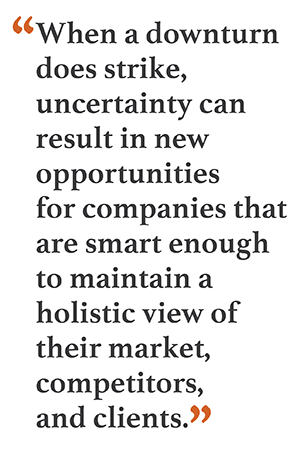
Over the past year, volatility in the global economic environment has been driven by the ongoing trade dispute between the United States and China, the stalling of the Brexit process, and elevated corporate debt levels. Although the domestic economy remains strong—for now—business leaders who are not concerned about trends in global markets should be.
For the fifth quarter in a row, Dun & Bradstreet's Q3/2019 Global Business Risk Report shows an elevated level of risk for cross-border businesses. In fact, the U.S.-China trade war, Brexit, and corporate debt are just a subset of the challenges that drove global companies' risk in Q2/2019 to its highest level since we launched the "global business impact" (GBI) score six years ago. The third quarter was slightly improved, but risk remained far above average.
Despite the storm clouds on the horizon, Dun & Bradstreet found that fewer delinquencies and business failures occurred in the first quarter of 2019 than in Q4/2018. A separate review of global business bankruptcies showed a reduction in 2018 compared with the year before. For now, companies seem to be weathering regional and global uncertainties. Even so, treasury and finance teams cannot afford to be blind to the very real risks stalking the global economy.
Trying to predict precisely when an economic downturn will begin is a fool's errand. However, it is prudent to take steps to monitor risks and prepare for a slowdown. Economic deterioration is inevitable in the long run. Whether global growth contracts this month, later this year, or further down the road, gaining an accurate view of your company's exposure to knowable risks can help you plan on how best to limit those risks' effects.
Here are three important principles finance leaders should consider adopting in preparation for an economic downturn:
1. Use both human and machine intelligence to calculate risk from customers, suppliers, and business partners.
We often speak of economic downturns as if every business's health moves in lockstep with the major stock indices. The reality is that some industries and companies suffer more than others in a recession. Understanding the health of your sector—and that of your customers, suppliers, and partners—is just as important as watching the markets. Too many businesses set defensive lines around only their own operations, but the first sign of trouble might appear somewhere else in the supply chain. Gaining an accurate picture of where risks lie in your organization's supply chain is crucial to understanding your own vulnerabilities.
 Other businesses aren't usually
eager to share information about their financial struggles or
concerns, but there are ways for customers and suppliers to try to
peek behind the curtain. First, don't discount the value of keeping
your ear to the ground. Your company's sales, billing, or
procurement staff may have insights based on conversations with
their counterparts in partner organizations. Information from those
on the floor might be your first indication that a customer or
supplier is struggling.
Other businesses aren't usually
eager to share information about their financial struggles or
concerns, but there are ways for customers and suppliers to try to
peek behind the curtain. First, don't discount the value of keeping
your ear to the ground. Your company's sales, billing, or
procurement staff may have insights based on conversations with
their counterparts in partner organizations. Information from those
on the floor might be your first indication that a customer or
supplier is struggling.
That said, you don't want to base your risk strategy on rumors. How can a treasury or finance manager get objective information on the company's risk exposure?
In addition to staying abreast of news via industry publications and mass media, look at your third-party business information providers as a valuable source of risk information. Many of these companies offer services that enable customers to check and monitor business credit scores, trade references, mergers and acquisitions, legal judgments, and other important events and transactions. You don't have to manually review all this information to separate the wheat from the chaff. Increasingly, treasury and finance teams are harnessing artificial intelligence (AI) technologies to score other companies along various risk factors. Predictive analytics can identify underlying patterns that predict which business partners are at risk of paying late, defaulting, or going out of business entirely.
AI has already demonstrated its usefulness in financial risk management. The ability to process vast amounts of data gives machines an advantage, enabling their human counterparts to focus on strategy rather than wading through large volumes of often-irrelevant information. In credit risk management, for example, AI models can compare the behavior of a business partner against industry benchmarks and raise a red flag anytime the partner falls outside the normal range for a given metric.
Rather than resisting AI as a potential job killer, finance professionals should be optimistic that it will improve their effectiveness at strategic decision-making. Today, treasury and finance leaders can access more data and computing power than ever before. Unfortunately, many find that a legacy information infrastructure and insufficient resources or training hamper their ability to make the most of these tools. Utilizing AI and analytics to build a modern, predictive risk management infrastructure is a crucial step in preparing for the next economic downturn, whenever it may strike.
2. Master your data to free up your team for higher-value activities.
Automating basic tasks may not be as exciting as learning to leverage leading-edge AI models, but it's an important part of effectively managing risk. That's because the same vast quantities of data that make AI and analytics so valuable to today's treasury and finance teams can have a downside for staff efficiency.
Businesses, customers, suppliers, and partners are generating huge amounts of information. Third-party data providers, government agencies, and other parties collect and distribute this information via application programming interfaces (APIs) and tools—but incorporating this data into business processes in a way that effectively supports decision-making remains a challenge for many companies. When outdated technologies limit connections between internal systems and external data providers, the workaround often involves manual data entry by a highly skilled employee whose time would be much better spent on analysis and problem-solving, or on cross-departmental communication, reaching out to colleagues to share information and seek outside opinions.
Automation can also cut down on simple mistakes in data entry and may allow for more timely updates of information. When volatility is the norm, having the latest information can make the difference between spotting a risk in time versus missing it and having to deal with the consequences. Once a company is connected to a business information provider, the treasury and finance teams can receive details on a regular basis, rather than an arbitrary timeline based on staff resources. Automating data collection and integration should be a priority for treasury and finance departments.
3. Use analytics to identify hidden opportunities.
When an economic downturn does strike, your company's response shouldn't be to simply circle the wagons around the business and ride it out. Uncertainty can result in new opportunities for companies that are smart enough to maintain a holistic view of their market, competitors, and clients. Developing such a view often falls to the treasury and finance functions because those groups tend to be hubs of information, by virtue of the volume and types of data they collect. This data enables treasury and finance leaders to understand business opportunities in ways other functions do not.
Sharing critical information with sales, marketing, procurement, and other departments may reveal previously overlooked opportunities, ultimately helping insulate the company from the worst effects of economic volatility. For example, a supplier might monitor the performance of a major competitor to look for signs of financial stress using tools that automatically alert staff to situations such as an increase in late payments or legal trouble. Their customers may be aware of these challenges, as well. This information could be passed along to the sales team as they target potential clients dissatisfied with their current vendor.
Current customers can also present new opportunities. If one of your clients is hard-hit by a slowdown, sharing solid data on the customer's financials with your own organization's billing or procurement department might encourage your colleagues to offer more favorable payment terms. Showing them that other clients are faring better through the downturn might help dispel any concerns about favoritism. Supporting generous financing during a recession could save the contract with that customer in the short term and result in a stronger, more profitable relationship down the road.
Political tensions, trade disputes, and uncertainty over everything from government policy to long-term weather patterns are sending global risk to levels we haven't seen in years. Ignoring these warning signs, or simply nurturing an increasing sense of foreboding, is not a strategic move.
The treasury and finance teams can play a lead role in managing economic risk. From gathering information from other departments to deploying advanced analytics and AI to the front lines, the treasury and finance departments are uniquely positioned to help anticipate and overcome challenges posed by the next economic downturn, whenever it may arrive.
 Andrew Hausman
is general manager, finance solutions, at Dun & Bradstreet.
In this role, he is responsible for the strategy, product
development, and sales efforts for the company's Finance Solutions
product portfolio. Hausman has more than 25 years of experience in
financial markets information and technology. Prior to joining Dun
& Bradstreet, he was president of Interactive Data
Corporation's Pricing and Reference Data.
Andrew Hausman
is general manager, finance solutions, at Dun & Bradstreet.
In this role, he is responsible for the strategy, product
development, and sales efforts for the company's Finance Solutions
product portfolio. Hausman has more than 25 years of experience in
financial markets information and technology. Prior to joining Dun
& Bradstreet, he was president of Interactive Data
Corporation's Pricing and Reference Data.
© 2024 ALM Global, LLC, All Rights Reserved. Request academic re-use from www.copyright.com. All other uses, submit a request to [email protected]. For more information visit Asset & Logo Licensing.






